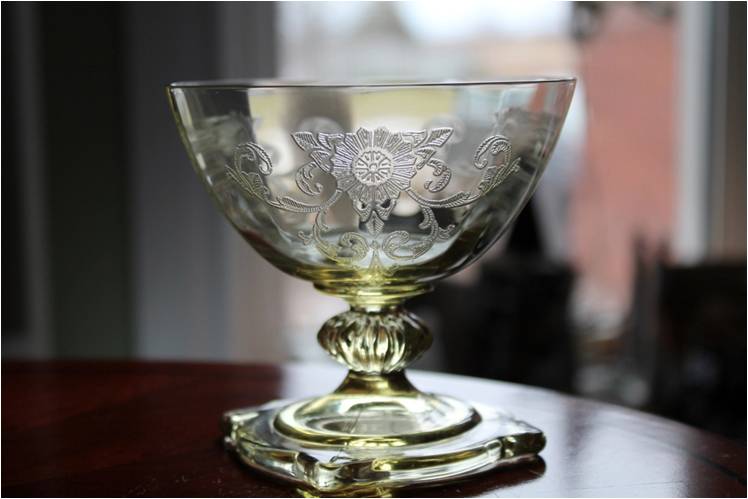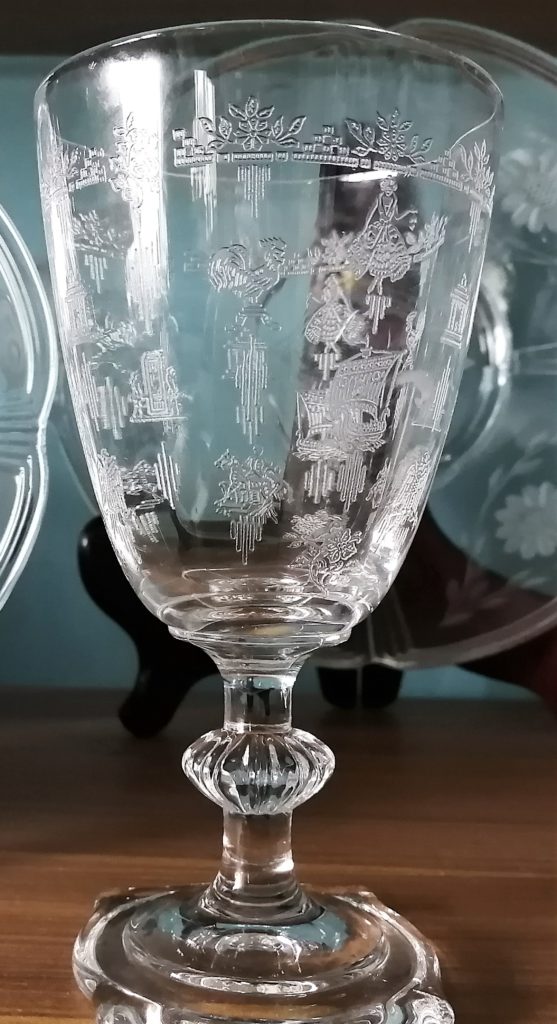Tags
Carcassonne, Coloured Glass, Depression Glass, Etched Glass, Floral Etch, Heisey, Lafayette, Old Colony, Plate Etched, Sherberts, Yellow Glass
I have just discovered that I have been spelling the name ‘Carcassonne’ incorrectly for years. Only used one ‘n’ instead of two. Got it now!
I have had this line with the Titania etch and saw this goblets recently and was intrigued by the plate etch – Lafayette – #451.
According to the Encyclopedia of Heisey Glassware volume one: Etchings & Carvings by Louise W, Ream, Neila M. Bredehoft and Thomas H. Bredehoft the etch was in production between 1930 and 1937. Given that Carcassonne was in production between 1930-1941, this stem is at least 84 years old! I bought a set of four and they are pristine. Someone(s) have taken good care of them all these years.
The authors also shared this quote from a Heisey ad: “Most delightful is the chintz pattern etching in Early American spirit of the  fine lead blown glassware…composed of a series of old chintz patterns artistically executed. A ship in full sail, a man on horseback, a Colonial girl, a pagoda are among the motifs admirably used in the general pattern.”
fine lead blown glassware…composed of a series of old chintz patterns artistically executed. A ship in full sail, a man on horseback, a Colonial girl, a pagoda are among the motifs admirably used in the general pattern.”
The etch was also used on the Empress line – #1401.
This goblet is a tall goblet. There was a shorter one with the same 11 ounce capacity. I think I prefer the taller style.
The Carcassonne line also came in flamingo, sahara, cobalt bowl/crystal stem and foot, and with an alexandrite bowl/crystal stem and foot. Scarce in amber and rare in a combination of sahara and alexandrite.
_____________________________________________________________________
January 26, 2015
 Isn’ t this cute? This is a little sherberts in Heisey’s line #3390 – Carcassonne. I really like the square feet. This line was in production from 1930 – 1938.
Isn’ t this cute? This is a little sherberts in Heisey’s line #3390 – Carcassonne. I really like the square feet. This line was in production from 1930 – 1938.
They are etched with etch #448 – Old Colony. I have acquired water goblets on a different blank with this etch – yet to be seen. I like the bead detail on the stem as well.
The colour is Heisey’s yellow – Sahara. Each company’s colours are slightly different. I find that the yellows aren’t my favourite. I like the blues and greens the best I think.
Nonetheless these are really sweet.







